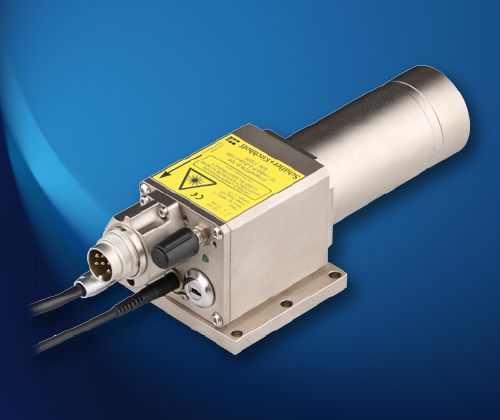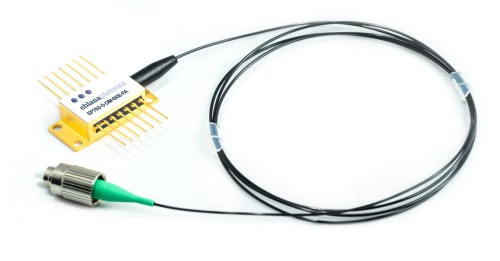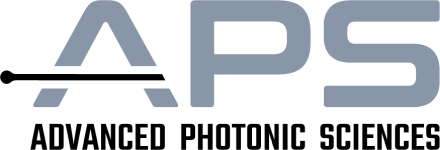fiber-coupled diode lasers (original) (raw)
Definition: diode laser devices where the generated light is coupled into an optical fiber
Alternative term: pigtailed diode lasers
Categories:  fiber optics and waveguides,
fiber optics and waveguides,  laser devices and laser physics
laser devices and laser physics
- semiconductor lasers
- diode lasers
* high-brightness laser diodes
* diode bars
* diode stacks
* vertical cavity surface-emitting lasers
* external-cavity diode lasers
* fiber-coupled diode lasers
* mode-locked diode lasers
* laser diode modules
* direct diode lasers
* (more topics)
- diode lasers
Related: laser diodesfibersbeam qualitybrightnesspolarization of light
Page views in 12 months: 3387
DOI: 10.61835/jks Cite the article: BibTex BibLaTex plain textHTML Link to this page! LinkedIn
Content quality and neutrality are maintained according to our editorial policy.
📦 For purchasing fiber-coupled diode lasers, use the RP Photonics Buyer's Guide — an expert-curated directory for finding all relevant suppliers, which also offers advanced purchasing assistance.
Contents
What is a Fiber-coupled Diode Laser?
For many applications, it is convenient to couple the output of a laser diode into an optical fiber to deliver the light to the place where it is needed.
Advantages and Drawbacks of Fiber Coupling
Fiber-coupled (also called fiber-integrated or fiber-pigtailed) diode lasers have several advantages:
- The light exiting the fiber has a circular and smooth (homogenized) intensity profile and a symmetric beam quality, which is in many cases very convenient. For example, less sophisticated optics are required for generating a circular pump spot for an end-pumped solid-state laser.
- It becomes possible to remove the laser diodes together with their cooling arrangements e.g. from a solid-state laser head, which can then be more compact, and more space is left for other parts at this place.
- Defective fiber-coupled diode lasers can easily be replaced without changing the alignment of the device where the light is used.
- Fiber-coupled devices can be easily combined with other fiber-optic components.

Figure 1: Photograph of fiber-coupled diode lasers from Coherent, having different kinds of fiber-optic cables. The image was kindly provided by Coherent.
Some potential disadvantages of fiber-coupled diode lasers, compared with free-space emitting lasers, are:
- The cost is higher. This may be offset, however, by the savings from simpler beam processing and delivery.
- The output power is slightly reduced, and more importantly the brightness (radiance). The loss of brightness can be substantial (more than an order of magnitude) or rather small, depending on the technique of fiber coupling. In some cases, this may not matter, but in other cases it introduces significant challenges e.g. for the design of a diode-pumped bulk laser or a high-power fiber laser.
- In most cases (particularly with multimode fibers), the fiber is not polarization-maintaining. The fiber output will then normally be partially polarized, and the polarization state can change when the fiber is moved or the temperature changes. This can cause substantial stability problems of diode-pumped solid-state lasers when the pump absorption is polarization-dependent (as in, e.g., Nd:YVO4).
One may also not obtain a fiber-coupled laser diode product for each optical wavelength.
Types of Fiber-coupled Diode Lasers
Many diode lasers are sold in fiber-coupled form, with robust fiber coupling optics (e.g., a permanent laser-welded fiber attachment) built into the laser package. The used fibers and techniques differ substantially for different diode lasers:
VECSELs
The simplest case is that of a VCSEL (vertical cavity surface-emitting laser), which usually emits a beam with high beam quality, moderate beam divergence, no astigmatism, and a circular intensity profile. A simple spherical lens is sufficient for imaging the emitting spot to the core of a single-mode fiber. The coupling efficiency can be of the order of 70–80%. It is also possible to couple directly (butt couple) the fiber to the emitting surface of the VCSEL.
Low-power Edge-emitting Laser Diodes
Small edge-emitting laser diodes also emit in a single spatial mode, thus in principle also allowing efficient coupling to a single-mode fiber. However, the coupling efficiency can be significantly degraded by the ellipticity of the beam, if a simple spherical lens is used. Also, the beam divergence is relatively high in at least one direction, requiring a lens with relatively high numerical aperture. Another problem is astigmatism of the diode output, particularly for gain-guided diodes; this may be compensated with an additional weak cylindrical lens. With output powers of up to a few hundred milliwatts, fiber-coupled gain-guided LDs can be used for, e.g., pumping erbium-doped fiber amplifiers.

Figure 2: Schematic setup of a simple fiber-coupled low-power edge-emitting laser diode. A spherical lens (or possibly a lens doublet) is used to image the laser diode facet to the fiber core. Beam ellipticity and astigmatism can degrade the coupling efficiency.
Broad Area Laser Diode
Broad area laser diodes are spatially multimode in the long direction of the emitter. If a circular beam is simply shaped with a cylindrical lens (e.g. a fiber lens, see Figure 3) and then launched into a multimode fiber, a lot of the brightness (radiance) will be lost because the high beam quality in the fast axis direction cannot be utilized. A power of e.g. 1 W can be launched into a multimode fiber with a 50-μm core diameter and a numerical aperture (NA) of 0.12. This is sufficient e.g. for pumping a low-power bulk laser, e.g. a microchip laser. Even a launched power of 10 W is possible.

Figure 3: Schematic setup of a simple fiber-coupled broad-area laser diode. A fiber lens is used to collimate the beam in the fast axis direction.
An improved technique for broad-area lasers is based on reshaping the beam for a symmetrized beam quality (and not only symmetrized beam radius) before launching. That allows for a higher brightness.
Diode Bars
For diode bars (diode arrays), the problem of asymmetric beam quality is even more severe. Here, the outputs of individual emitters may be coupled into separate fibers of a fiber bundle. The fibers are arranged in a linear array on the side of the diode bar, but as a circular array on the output end. Alternatively, some kind of beam shaper for symmetrizing the beam quality may be used before launching into a single multimode fiber. This can be done e.g. with a two-mirror beam shaper or with some micro-optic elements. It is possible e.g. to couple 30 W into a fiber with 200-μm (or even 100-μm) core diameter and an NA of 0.22. Such a device can be used for, e.g., pumping an Nd:YAG or Nd:YVO4 laser with roughly 15 W of output power.
Diode Stacks
For diode stacks, fibers with still larger core diameters are used. It is possible e.g. to couple hundreds of watts (or even several kilowatts) of optical power into a fiber with a 600-μm core diameter and NA = 0.22.
Beam Quality of the Fiber Output
The beam quality of the fiber output is often not specified; in many cases, only the fiber core diameter and the numerical aperture (NA) are known, and a step-index multimode fiber is assumed. There is no equation to calculate exactly the beam quality in that case because it depends on the distribution of optical power over the fiber modes, and this distribution itself depends on the launching conditions. However, the beam quality _M_2 factor can be roughly estimated, assuming that the power is well distributed over the modes, so that the numerical aperture represents a reasonable (perhaps slightly too high) estimate for the actual beam divergence. This leads to the equation {M^2} \approx \frac{{\pi \: r_\rm{co}}}{\lambda }{\rm{NA}}$$
where ($r_\rm{co}$) is the fiber core radius (i.e., half the core diameter). If the light is launched mostly in lower-order guided fiber modes, the beam quality can also be substantially better, but may then be degraded by strong bending of the fiber.
Frequently Asked Questions
What is a fiber-coupled diode laser?
A fiber-coupled diode laser is a laser diode where the output light is permanently directed into an optical fiber. This setup allows the light to be conveniently delivered from the laser source to the point of application.
What are the main advantages of using fiber-coupled diode lasers?
They produce a symmetric, homogenized beam profile, allow the laser source and its cooling system to be placed remotely, and are easily replaced. They also integrate well with other fiber-optic components.
What are the drawbacks of fiber-coupled diode lasers?
Compared to free-space diodes, they have a higher cost and a slight reduction in output power. More importantly, they can suffer a significant loss of brightness, and their output polarization can be unstable with standard fibers.
Why is the brightness of a diode laser often reduced by fiber coupling?
Many diode lasers, like broad-area diodes, have asymmetric beam quality. Simple coupling into a circular fiber does not preserve the high quality of the fast axis, spreading the power over many fiber modes, which reduces the overall brightness (radiance).
How are high-power diode bars coupled into optical fibers?
One method is to couple the output of each emitter into a separate fiber within a fiber bundle. Alternatively, a beam shaper can symmetrize the combined beam before launching it into a single large-core multimode fiber.
How can one estimate the beam quality of the output from a multimode fiber?
Assuming the power is well distributed over the fiber modes, the _M_2 factor can be roughly estimated using the equation (${M^2} \approx (\pi \: r_\rm{co} / \lambda) \cdot {\rm{NA}}$), where ($r_\rm{co}$) is the fiber core radius and NA is the numerical aperture.
Suppliers
Sponsored content: The RP Photonics Buyer's Guide contains 89 suppliers for fiber-coupled diode lasers. Among them:
⚙ hardware
The fiber-coupled laser diode beam sources of type 51nano-S by Schäfter+Kirchhoff have reduced power noise (< 0.1% RMS (< 1 MHz)), reduced coherence length (≈ 300 µm) and a low speckle contrast as a result of the internal RF modulation. They are available with wavelengths from 405 nm to 1550 nm.
⚙ hardware
Monocrom has developed highly efficient fiber-coupled diode lasers. The Monocrom solder-free laser bar Clamping™ technique avoids any “smile” effect and thus allows for an optimum coupling efficiency.
We also provide wavelength-stabilized laser modules with a grating for wavelength locking.
For the most demanding applications of high brightness (radiance), we offer fiber-coupled high power diode laser systems capable of delivering 1 kW continuous-wave power.
⚙ hardware
QPC Lasers products range from sub-watt single-mode PM fiber coupled diodes for LIDAR and communications to multi-mode fiber-coupled modules with outputs in the hundreds of watts for medical, materials processing and pumping applications. Optional features include Brightlock monolithically spectrally stabilized diodes for unmatched linewidth and spectral control.
⚙ hardware
Serving North America, RPMC Lasers offers a wide range customizable, UV-SWIR fiber-coupled lasers providing consistent beam quality with a controlled light profile and smooth, circular output, ensuring stable performance and accurate focusability on small areas for high-precision applications.
Enhanced flexibility comes from replaceable diodes for seamless maintenance without realignment, plus fiber-coupling for adaptable setups, convenient beam delivery in tight spaces, and remote control of output.
They integrate easily with fiber-optic components like amplifiers or gratings for increased power and wavelength stability, while the fiber’s heat dissipation minimizes cooling needs, improving longevity and reliability in high-power uses.
Let RPMC help you find the right laser today!
⚙ hardware
Bright Solutions offers the BDL and BFD — fiber-coupled diode laser modules:
- up to 200 W cw (or 400 W quasi-cw) in a 200-μm core fiber
- flat top beam profile
- integrated TE cooler, current and temperature controller
- optional fiber sensor
- pulsed models are available
They are used e.g. for pumping of solid-state and fiber lasers, material processing or illumination.
⚙ hardware
Sacher Lasertechnik offers various types of fiber-pigtailed laser diodes, including both DFB and DBR lasers.
⚙ hardware
The Lumics fiber-coupled diode lasers are perfect for OEM integrators developing advanced end-user laser systems, featuring single emitters with exceptional longevity. Lumics offers single-mode 14-pin BTF lasers for high-precision industrial applications and multi-mode diode laser modules in various sizes, customizable to meet specific customer needs. The multi-mode, multi-emitter packages are designed for detachable fibers with core diameters ranging from 105 µm to 1000 µm. Users can specify wavelengths, power levels, and fiber core diameters to ensure an optimal diode laser match for their applications.
⚙ hardware
Eblana Photonics' core product offerings are based on our patented Discrete-Mode (DFB like) manufacturing technology, which delivers industry leading performance with fully scalable, consistent production and integration capability.
Eblana’s products are used extensively for trace gas sensing and environmental monitoring in the near- and mid-IR.
In addition, the inherent low linewidth performance of the DM platform in comparison to typical DFB lasers is uniquely suited to distributed fibre sensing and LIDAR applications, as well as scientific and metrology projects.
Available in a variety of industry standard and custom package types, Eblana can also help you realise any custom wavelength requirements with a proven track record of success.
⚙ hardware
APS now offers 445 nm (blue) fiber-coupled laser modules with varying powers of 50 W, 100 W, 150 W and 200 W. With the exception of the 50 W power module, all units are self-contained, internally-cooled, and designed for mounting. These units, equipped with a SMA connector at the fiber output, can be used for various applications such as illumination, cutting, engraving, and more.
⚙ hardware
Sheaumann’s fiber-coupled modules are well-suited for applications where a circular, homogenized beam is desired, such as those utilizing DPSS end-pumping or compact ones requiring simple optics. Using proprietary diode fabrication and fiber preparation/alignment processes to achieve a low-noise output, Sheaumann offers modules with a high beam quality ideal for such applications as spectroscopy and free-space optical communications. These unique technologies also reduce speckle, and when paired with an appropriate connector, modules can be used as high-performance pointing devices. Let Sheaumann custom design your module, from diode to fiber to package, to work optimally in your system and outperform your competition.
⚙ hardware
CSRayzer provides many kinds of fiber coupled diode lasers, e.g. for fiber amplifier pumping, but also pulsed DFB laser modules with narrow linewidth.
⚙ hardware
All series of CNI laser modules can be fiber-coupled with a choice of different fibers such as single-mode, polarization-maintaining or multimode. Even beam fiber coupling (with a flat beam profile) is also available.
⚙ hardware
While all of Toptica's diode lasers can be combined with Toptica's versatile fiber launch FiberDock™, we also offer dedicated, permanently fiber-coupled systems.
The iBeam-smart-PT as well as the Multi-Laser Engine iChrome xLE cover the range from 375–785 nm and provide a single-mode polarization maintaining fiber delivery.
Toptica's proprietary COOL technology enables drop-shipment and ensures constant output powers even under strongly varying ambient conditions.
⚙ hardware
Lumibird manufactures various fiber-coupled laser diodes modules with compact design, high peak power up to 600 W and high coupling efficiency. Fibers are field replaceable.
Questions and Comments from Users
Here you can submit questions and comments. As far as they get accepted by the author, they will appear above this paragraph together with the author’s answer. The author will decide on acceptance based on certain criteria. Essentially, the issue must be of sufficiently broad interest.
Please do not enter personal data here. (See also our privacy declaration.) If you wish to receive personal feedback or consultancy from the author, please contact him, e.g. via e-mail.
By submitting the information, you give your consent to the potential publication of your inputs on our website according to our rules. (If you later retract your consent, we will delete those inputs.) As your inputs are first reviewed by the author, they may be published with some delay.


























